Stripe-Patterned Al/PDMS Triboelectric Nanogenerator for a High-Sensitive Pressure Sensor and a Novel Two-Digit Switch with Surface-Edge Enhanced Charge Transfer Behavior
Abstract
1. Introduction
2. Materials and Methods
3. Results and Discussion
3.1. Laser Processing Rough Surface Morphology
3.2. The Output Performance of SR-TENG
3.3. The Influence of the Surface Roughness of the Tribolayer on Triboelectricity
3.4. The SR-PDMS for Energy Harvesting
3.5. The SR-PDMS as a Pressure Sensor and Used as a Two-Digit Switch
4. Conclusions
Supplementary Materials
Author Contributions
Funding
Data Availability Statement
Acknowledgments
Conflicts of Interest
References
- Song, R.; Huang, Y.; Wang, X.; Luo, H.J. A microsphere-structure flexible pressure sensor for monitoring keyboard typing behavior. Funct. Mater. Lett. 2024, 17, 2451026. [Google Scholar] [CrossRef]
- Garg, R.; Majhi, A.; Nagasreenivasarao, P.; Patra, N.R.; Barve, R.; Parida, K. Polarization-Induced Mechanically Socketed Ultra-Stretchable and Breathable Textile-Based Nanogenerator and Pressure Sensor. Adv. Funct. Mater. 2024, 34, 2401593. [Google Scholar] [CrossRef]
- Wang, W.C.; Zhao, C.; Wang, Z.Y.; Mao, B.J.; Wang, H.Y.; Zhang, Y.P.; Xi, Z.Y.; Xiang, C.; Xu, M.Y.; Qu, J.T. A Durable and Self-Powered Triboelectric Sensor for Hydraulic Pressure Monitoring and Underwater Disturbance Detection. IEEE Sens. J. 2024, 24, 18928–18936. [Google Scholar] [CrossRef]
- Shan, B.C.; Liu, C.X.; Chen, R.H.; Qu, G.H.; Sui, H.; Chen, N.X.; Xing, G.Y. A self-powered sensor for detecting slip state and pressure of underwater actuators based on triboelectric nanogenerator. Mater. Today Nano 2023, 24, 100391. [Google Scholar] [CrossRef]
- Yan, R.; Sun, Q.Z.; Shi, X.W.; Sun, Z.Q.; Tan, S.X.; Tang, B.; Chen, W.T.; Liang, F.; Yu, H.D.; Huang, W. Skin-interfaced self-powered pressure and strain sensors based on fish gelatin-based hydrogel for wireless wound strain and human motion detection. Nano Energy 2023, 118, 108932. [Google Scholar] [CrossRef]
- Lu, B.H.; Xie, L.J.; Lei, H.; Liu, Y.N.; Zhao, C.; Sun, X.H.; Wen, Z. Research Progress in Self-Powered Pressure Sensors for Internet of Healthcare. Adv. Mater. Technol. 2023, 9, 2301480. [Google Scholar] [CrossRef]
- Xia, L.T.; Xiao, W.; Li, L.X.; Liu, X.; Zhuang, Q.B.; Huang, Y.; Lan, T.H.; Du, X.H.; Zhao, Y.; Wu, D.Z. High-Performance Flexible Capacitive Pressure Sensor Based on a Spiked Nickel/Polyimide Composite Nanofiber Membrane. ACS Sens. 2025, 10, 1450–1460. [Google Scholar] [CrossRef]
- Zheng, B.W.; Guo, R.S.; Dou, X.Q.; Fu, Y.Q.; Yang, B.J.; Liu, X.Q.; Zhou, F. Blade-Coated Porous 3D Carbon Composite Electrodes Coupled with Multiscale Interfaces for Highly Sensitive All-Paper Pressure Sensors. Nano-Micro Lett. 2024, 16, 267. [Google Scholar] [CrossRef]
- Fan, J.S.; Xu, S.J.; Newell, B.; Garcia, J.; Wu, W.Z.; Nawrocki, R.A. Liquid-based material extrusion of flexible silver electrodes onto electrospun poly(vinylidene fluoride) microfibers for soft piezoelectric pressure sensors: Towards fully three-dimensional printed functional materials. Nano Energy 2025, 137, 110820. [Google Scholar] [CrossRef]
- Huang, Y.J.; Tsai, C.H.; Hung, C.W.; Chung, C.K. A PDMS-Al Triboelectric Nanogenerator Using Two-Pulse Laser to Enhance Effective Contact Area and Its Application. Polymers 2024, 16, 3397. [Google Scholar] [CrossRef]
- Huang, Y.J.; Chung, C.K. Design and Fabrication of Polymer Triboelectric Nanogenerators for Self-Powered Insole Applications. Polymers 2023, 15, 4035. [Google Scholar] [CrossRef]
- Lin, D.Y.; Chung, C.K. High-Performance Triboelectric Nanogenerator with Double-Side Patterned Surfaces Prepared by CO2 Laser for Human Motion Energy Harvesting. Micromachines 2024, 15, 1299. [Google Scholar] [CrossRef]
- Zhi, C.W.; Shi, S.; Si, Y.F.; Fei, B.; Huang, H.T.; Hu, J.L. Recent Progress of Wearable Piezoelectric Pressure Sensors Based on Nanofibers, Yarns, and Their Fabrics via Electrospinning. Adv. Mater. Technol. 2023, 8, 2201161. [Google Scholar] [CrossRef]
- Quan, T.; Wu, Y.; Yang, Y. Hybrid electromagnetic–triboelectric nanogenerator for harvesting vibration energy. Nano Res. 2015, 8, 3272–3280. [Google Scholar] [CrossRef]
- Ma, M.; Kang, Z.; Liao, Q.; Zhang, Q.; Gao, F.; Zhao, X.; Zhang, Z. Development, applications, and future directions of triboelectric nanogenerators. Nano Res. 2018, 11, 2951–2969. [Google Scholar] [CrossRef]
- Wang, Z.L. Triboelectric nanogenerators as new energy technology for self-powered systems and as active mechanical and chemical sensors. ACS Nano 2013, 7, 9533–9557. [Google Scholar] [CrossRef] [PubMed]
- Zou, H.; Zhang, Y.; Guo, L.; Wang, P.; He, X.; Dai, G.; Wang, Z.L. Quantifying the triboelectric series. Nat. Commun. 2019, 10, 1427. [Google Scholar] [CrossRef]
- Ke, K.H.; Chung, C.K. High-Performance Al/PDMS TENG with Novel Complex Morphology of Two-Height Microneedles Array for High-Sensitivity Force-Sensor and Self-Powered Application. Small 2020, 16, 2001209. [Google Scholar] [CrossRef]
- Chung, C.K.; Ke, K.H. High contact surface area enhanced Al/PDMS triboelectric nanogenerator using novel overlapped microneedle arrays and its application to lighting and self-powered devices. Appl. Surf. Sci. 2020, 508, 145310. [Google Scholar] [CrossRef]
- Trinh, V.L.; Chung, C.K. A Facile Method and Novel Mechanism Using Microneedle-Structured PDMS for Triboelectric Generator Applications. Small 2017, 13, 1700373. [Google Scholar] [CrossRef]
- Fan, F.R.; Lin, L.; Zhu, G.; Wu, W.; Zhang, R.; Wang, Z.L. Transparent triboelectric nanogenerators and self-powered pressure sensors based on micropatterned plastic films. Nano Lett. 2012, 12, 3109–3114. [Google Scholar] [CrossRef]
- Jeong, C.K.; Baek, K.M.; Niu, S.; Nam, T.W.; Hur, Y.H.; Park, D.Y.; Hwang, G.T.; Byun, M.; Lee, K.J. Topographically-designed triboelectric nanogenerator via block copolymer self-assembly. Nano Lett. 2014, 14, 7031–7038. [Google Scholar] [CrossRef]
- Chen, H.; Xu, Y.; Zhang, J.; Wu, W.; Song, G. Self-Powered Flexible Blood Oxygen Monitoring System Based on a Triboelectric Nanogenerator. Nanomaterials 2019, 9, 778. [Google Scholar] [CrossRef]
- Ren, Z.; Nie, J.; Shao, J.; Lai, Q.; Wang, L.; Chen, J.; Chen, X.; Wang, Z.L. Fully elastic and metal-free tactile sensors for detecting both normal and tangential forces based on triboelectric nanogenerators. Adv. Funct. Mater. 2018, 28, 1802989. [Google Scholar] [CrossRef]
- Saadatnia, Z.; Esmailzadeh, E.; Naguib, H.E. High performance triboelectric nanogenerator by hot embossing on self-assembled micro-particles. Adv. Eng. Mater. 2019, 21, 1700957. [Google Scholar] [CrossRef]
- Song, J.; Gao, L.; Tao, X.; Li, L. Ultra-Flexible and large-area textile-based triboelectric nanogenerators with a sandpaper-induced surface microstructure. Materials 2018, 11, 2120. [Google Scholar] [CrossRef]
- Mariello, M.; Scarpa, E.; Algieri, L.; Guido, F.; Mastronardi, V.M.; Qualtieri, A.; De Vittorio, M. Novel flexible triboelectric nanogenerator based on metallized porous PDMS and parylene C. Energies 2020, 13, 1625. [Google Scholar] [CrossRef]
- Tu, K.T.; Chung, C.K. Rapid prototyping of biodegradable microneedle arrays by integrating CO2 laser processing and polymer molding. J. Micromech. Microeng. 2016, 26, 065015. [Google Scholar] [CrossRef]
- Yin, G.F.; Liang, X.X.; Zhang, Y.; Li, J.; Wei, S.M. Fountain-inspired triboelectric nanogenerator as rotary energy harvester and self-powered intelligent sensor. Nano Energy 2025, 137, 110779. [Google Scholar] [CrossRef]
- Hu, L.K.; Meng, H.; Xu, Z.G.; Wang, Y. A self-powered wearable sensor for infant fall detection based on triboelectric nanogenerator. Appl. Phys. A-Mater. Sci. Process. 2025, 131, 164. [Google Scholar] [CrossRef]
- Zhang, C.G.; Liu, H.P.; Hao, Y.J.; Yang, J.Y.; Qiao, W.Y.; Qin, Y.; Su, W.; Zhang, H.K.; Wang, J.; Li, X.H. Triboelectric nanogenerator for Self-Powered musical instrument sensing based on the Ion-Electricfield-Migration Nylon/Na2SO4 nanofiber film. Chem. Eng. J. 2024, 489, 151274. [Google Scholar] [CrossRef]
- Chen, Y.D.; Lv, C.H.; Ye, X.L.; Ping, J.F.; Ying, Y.B.; Lan, L.Y. Hydrogel-based pressure sensors for electronic skin systems. Matter 2025, 8, 101992. [Google Scholar] [CrossRef]
- Song, Y.D.; Sun, W.L.; Shi, X.J.; Qin, Z.; Wu, Q.Q.; Yin, S.Y.; Liang, S.; Liu, Z.N.; Sun, H. Bio-inspired e-skin with integrated antifouling and comfortable wearing for self-powered motion monitoring and ultra-long-range human-machine interaction. J. Colloid Interface Sci. 2025, 679, 1299–1310. [Google Scholar] [CrossRef] [PubMed]
- Chen, J.; Zhu, G.; Yang, W.; Jing, Q.; Bai, P.; Yang, Y.; Hou, T.C.; Wang, Z.L. Harmonic-Resonator-Based Triboelectric Nanogenerator as a Sustainable Power Source and a Self-Powered Active Vibration Sensor. Adv. Mater. 2013, 25, 6094–6099. [Google Scholar] [CrossRef] [PubMed]
- Wang, Z.; Liu, W.L.; Hu, J.L.; He, W.C.; Yang, H.K.; Ling, C.; Xi, Y.; Wang, X.; Liu, A.P.; Hu, C.G. Two voltages in contact-separation triboelectric nanogenerator: From asymmetry to symmetry for maximum output. Nano Energy 2020, 69, 104452. [Google Scholar] [CrossRef]
- Dharmasena, R.D.I.G. Inherent asymmetry of the current output in a triboelectric nanogenerator. Nano Energy 2020, 76, 105045. [Google Scholar] [CrossRef]
- Yang, Y.; Zhang, H.L.; Lin, Z.H.; Zhou, Y.S.; Jing, Q.S.; Su, Y.J.; Yang, J.; Chen, J.; Hu, C.G.; Wang, Z.L. Human Skin Based Triboelectric Nanogenerators for Harvesting Biomechanical Energy and as Self-Powered Active Tactile Sensor System. ACS Nano 2013, 7, 9213–9222. [Google Scholar] [CrossRef]
- Chun, J.; Kim, J.W.; Jung, W.S.; Kang, C.Y.; Kim, S.W.; Wang, Z.L.; Baik, J.M. Mesoporous pores impregnated with Au nanoparticles as effective dielectrics for enhancing triboelectric nanogenerator performance in harsh environments. Energy Environ. Sci. 2015, 8, 3006–3012. [Google Scholar] [CrossRef]
- Gao, Y.Y.; Xu, B.A.; Tan, D.; Li, M.Q.; Wang, Y.T.; Yang, Y.J. Asymmetric-elastic-structure fabric-based triboelectric nanogenerators for wearable energy harvesting and human motion sensing. Chem. Eng. J. 2023, 466, 143079. [Google Scholar] [CrossRef]
- Luo, A.X.; Tan, Q.X.; Xu, W.H.; Huang, J.L.; Gu, S.H.; Guo, X.E.; Lee, C.K.; Fan, K.Q.; Wang, F. A Comprehensive Review of Energy Harvesting From Kinetic Energy at Low Frequency. Adv. Mater. Technol. 2025, 202401731. [Google Scholar] [CrossRef]
- Wu, X.Q.; Cai, T.T.; Wu, Q.; Meng, J.; Wang, W.Q.; Li, W.T.; Hu, C.P.; Zhang, X.L.; Wang, D.A. Droplet-Based Triboelectric Nanogenerators with Needle Electrodes for Efficient Water Energy Harvesting. ACS Appl. Mater. Interfaces 2025, 17, 13762–13772. [Google Scholar] [CrossRef]
- Pandey, P.; Thapa, K.; Ojha, G.P.; Seo, M.K.; Shin, K.H.; Kim, S.W.; Sohn, J.I. Metal-organic frameworks-based triboelectric nanogenerator powered visible light communication system for wireless human-machine interactions. Chem. Eng. J. 2022, 452, 139209. [Google Scholar] [CrossRef]
- Hajra, S.; Panda, S.; Song, S.; Song, H.; Panigrahi, B.K.; Jeong, S.M.; Mishra, Y.K.; Kim, H.J. Simultaneous Triboelectric and Mechanoluminescence Sensing Toward Self-Powered Applications. Adv. Sustain. Syst. 2024, 8, 2400609. [Google Scholar] [CrossRef]
- Jiang, Y.; Ming, Y.T.; Zhao, M.H.; Guo, X.; Han, J.J.; Liu, S.J.; Jiang, T.; Wang, Z.L. Self-Powered Traffic Lights Through Wind Energy Harvesting Based on High-Performance Fur-Brush Dish Triboelectric Nanogenerators. Small 2025, 20, 2402661. [Google Scholar] [CrossRef] [PubMed]
- Chen, W.D.; Kang, J.X.; Zhang, J.Z.; Zhang, Y.A.; Zhou, X.T.; Yan, Q.; Kim, H.S.; Guo, T.L.; Wu, C.X.; Kim, T.W. An information display and encrypted transmission system based on a triboelectric nanogenerator and a cholesteric liquid crystal. Nano Energy 2025, 134, 110594. [Google Scholar] [CrossRef]
- Wu, Y.; Luo, Y.; Qu, J.; Daoud, W.A.; Qi, T. Nanogap and Environmentally Stable Triboelectric Nanogenerators Based on Surface Self-Modified Sustainable Films. ACS Appl. Mater. Interfaces 2020, 12, 55444–55452. [Google Scholar] [CrossRef]
- Bai, P.; Zhu, G.; Jing, Q.; Yang, J.; Chen, J.; Su, Y.; Ma, J.; Zhang, G.; Wang, Z.L. Membrane-based self-powered triboelectric sensors for pressure change detection and its uses in security surveillance and healthcare monitoring. Adv. Funct. Mater. 2014, 24, 5807–5813. [Google Scholar] [CrossRef]
- Cao, Y.L.; Guo, Y.B.; Chen, Z.X.; Yang, W.F.; Li, K.R.; He, X.Y.; Li, J.M. Highly sensitive self-powered pressure and strain sensor based on crumpled MXene film for wireless human motion detection. Nano Energy 2022, 92, 106689. [Google Scholar] [CrossRef]
- Gunasekhar, R.; Reza, M.S.; Kim, K.J.; Prabu, A.A.; Kim, H. Electrospun PVDF/aromatic HBP of 4th gen based flexible and self-powered TENG for wearable energy harvesting and health monitoring. Sci. Rep. 2024, 13, 22645. [Google Scholar] [CrossRef]
- Hao, Y.J.; Ji, T.; Zhang, J.; Chen, W.L. Triboelectric nanogenerator based on changing the nanomorphology of polyoxometalates for gait monitoring of teenagers. Nano Res. 2025, 18, 94907192. [Google Scholar] [CrossRef]
- Liu, W.Q.; Chen, M.; Jiang, X.P.; Chen, W.; Zeng, S.; Ren, Z.Y.; Guo, H.Y.; Yu, H. Dynamic keystroke-password recognition based on piezoelectric-triboelectric coupling sensor array with crosstalk-free for authentication system. Nano Energy 2025, 136, 110667. [Google Scholar] [CrossRef]
- Aliyana, A.K.; Bairagi, S.; Kumar, C.; Mulvihill, D.M.; Stylios, G.K. Investigating superior performance by configuring bimetallic electrodes on fabric triboelectric nanogenerators (F-TENGs) for IoT enabled touch sensor applications. Nano Energy 2024, 130, 110125. [Google Scholar] [CrossRef]
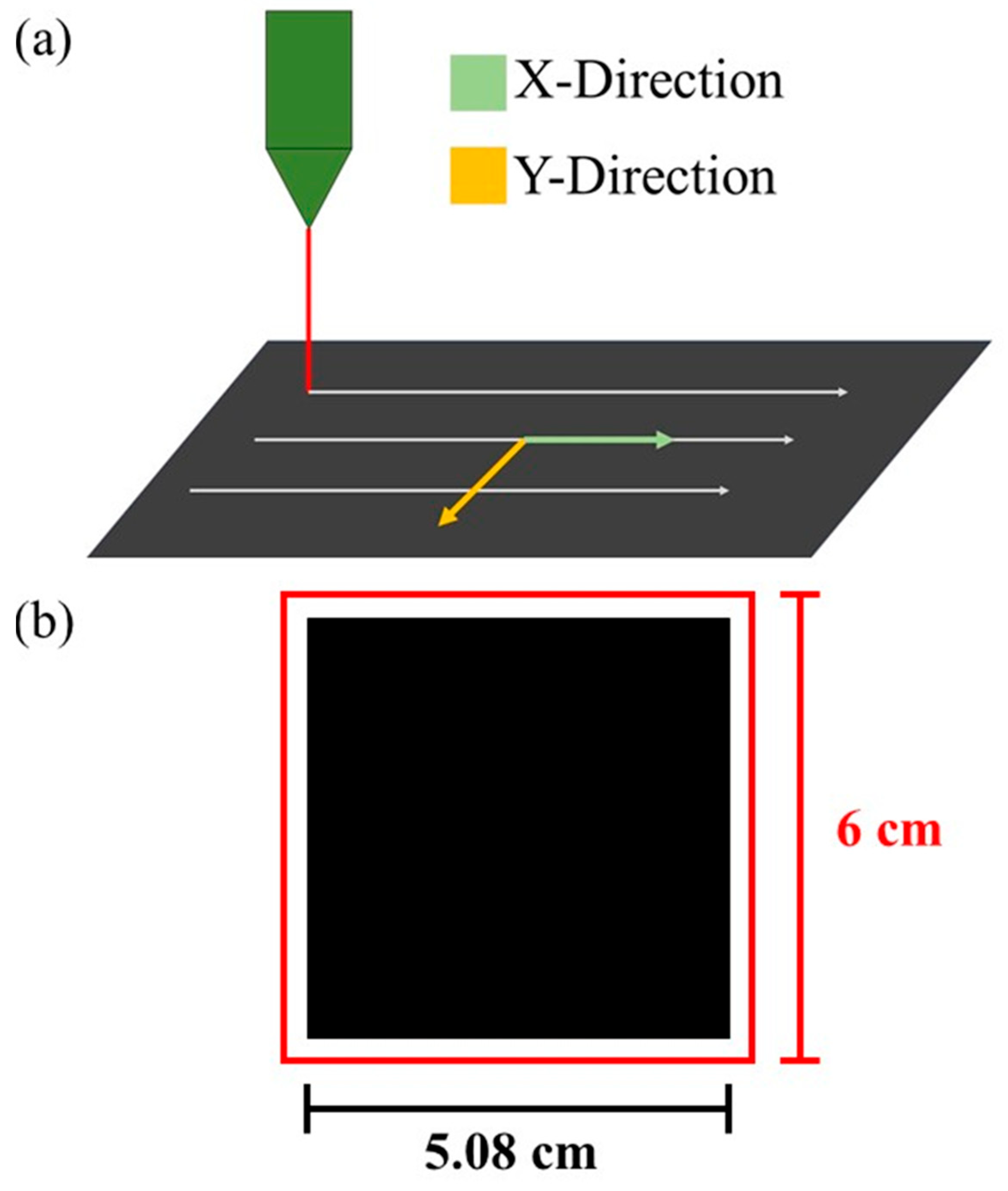


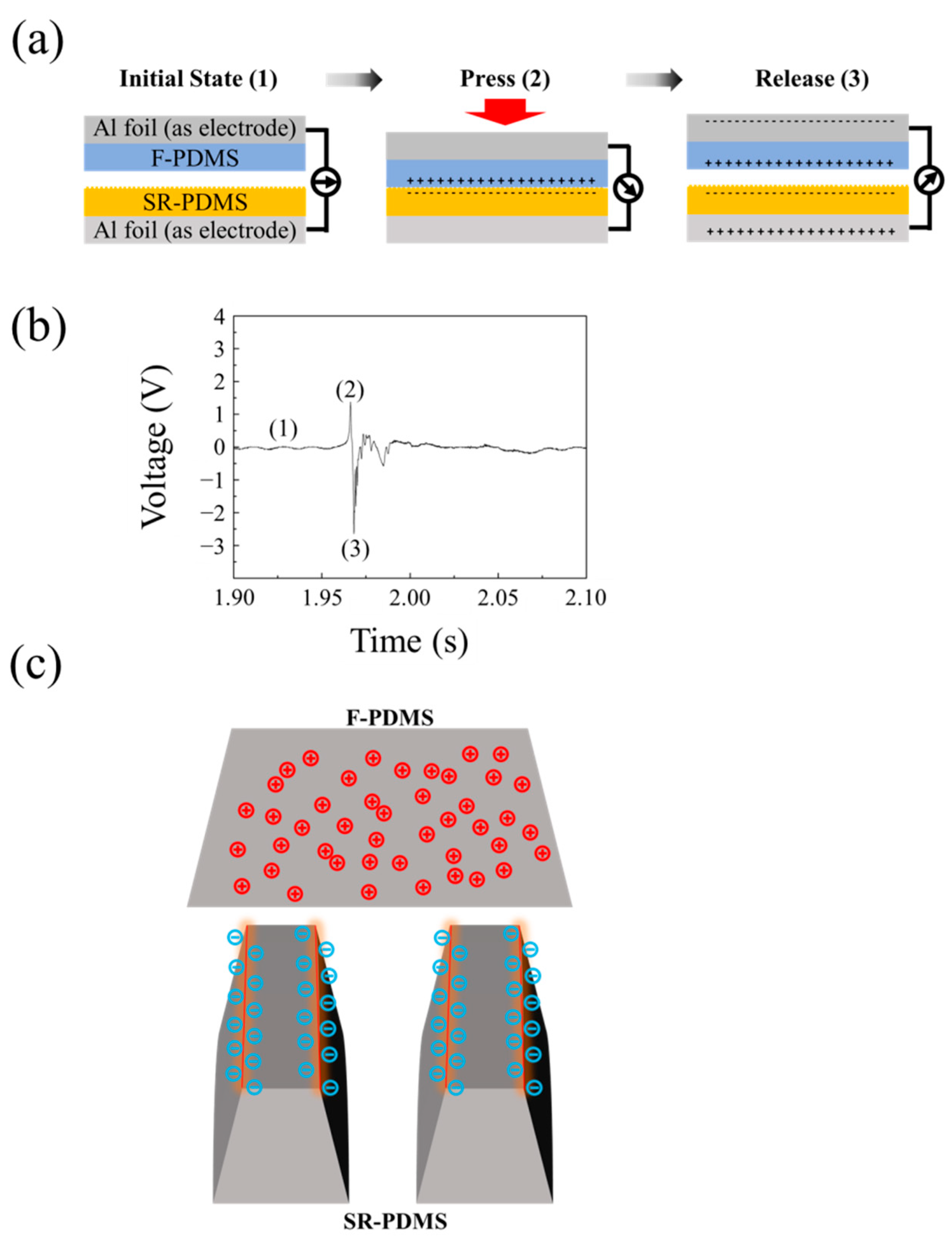
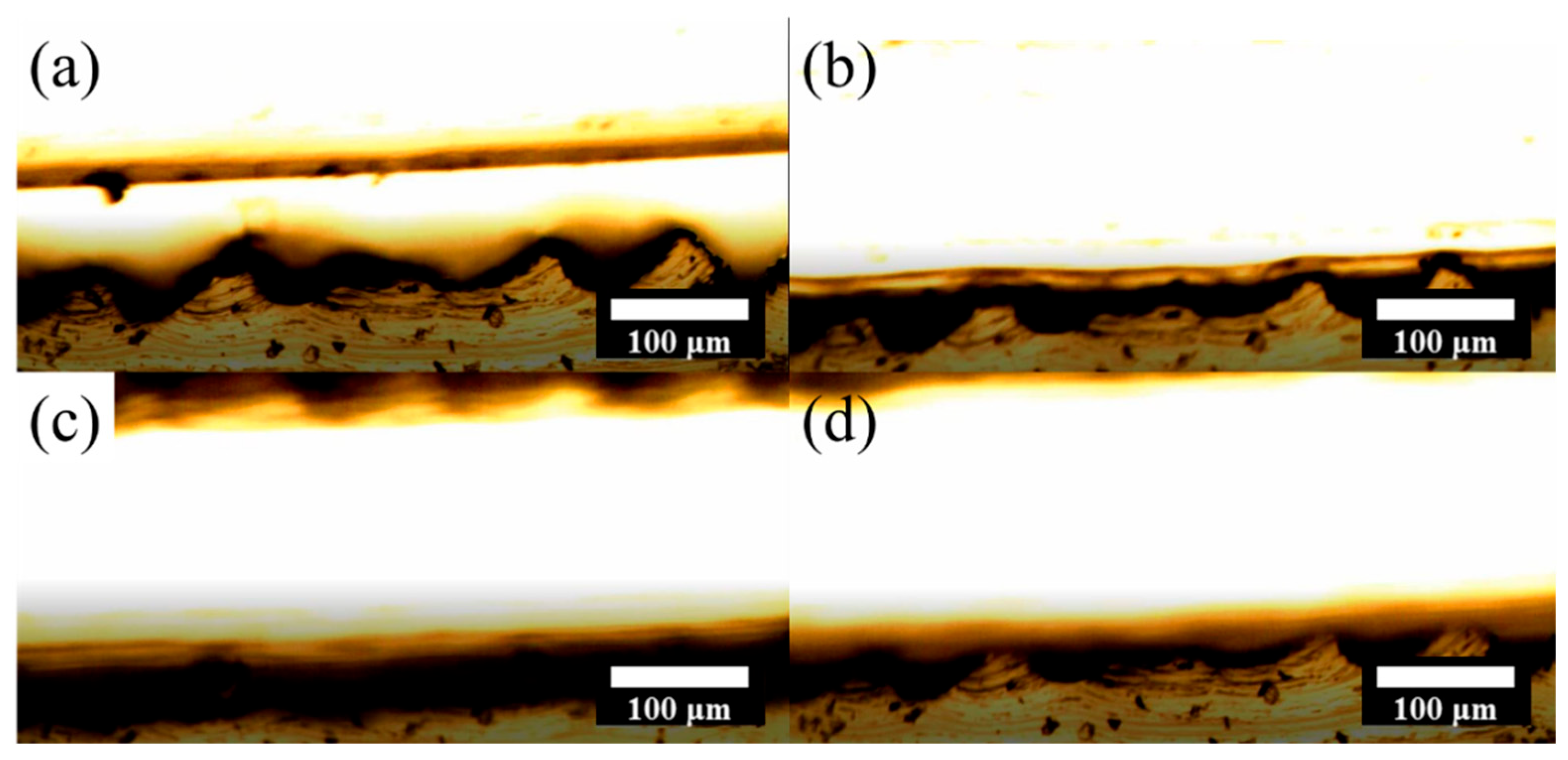
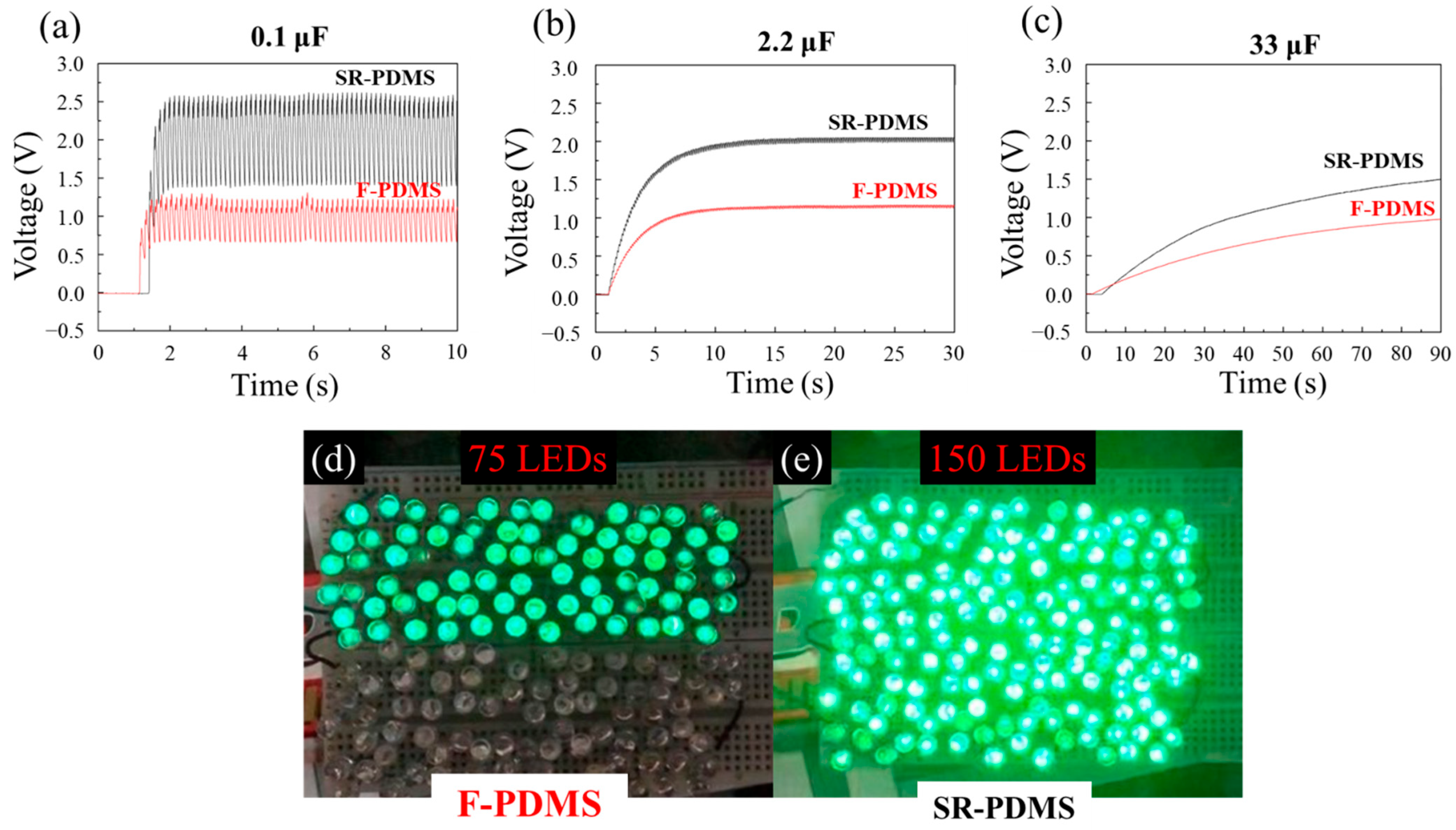

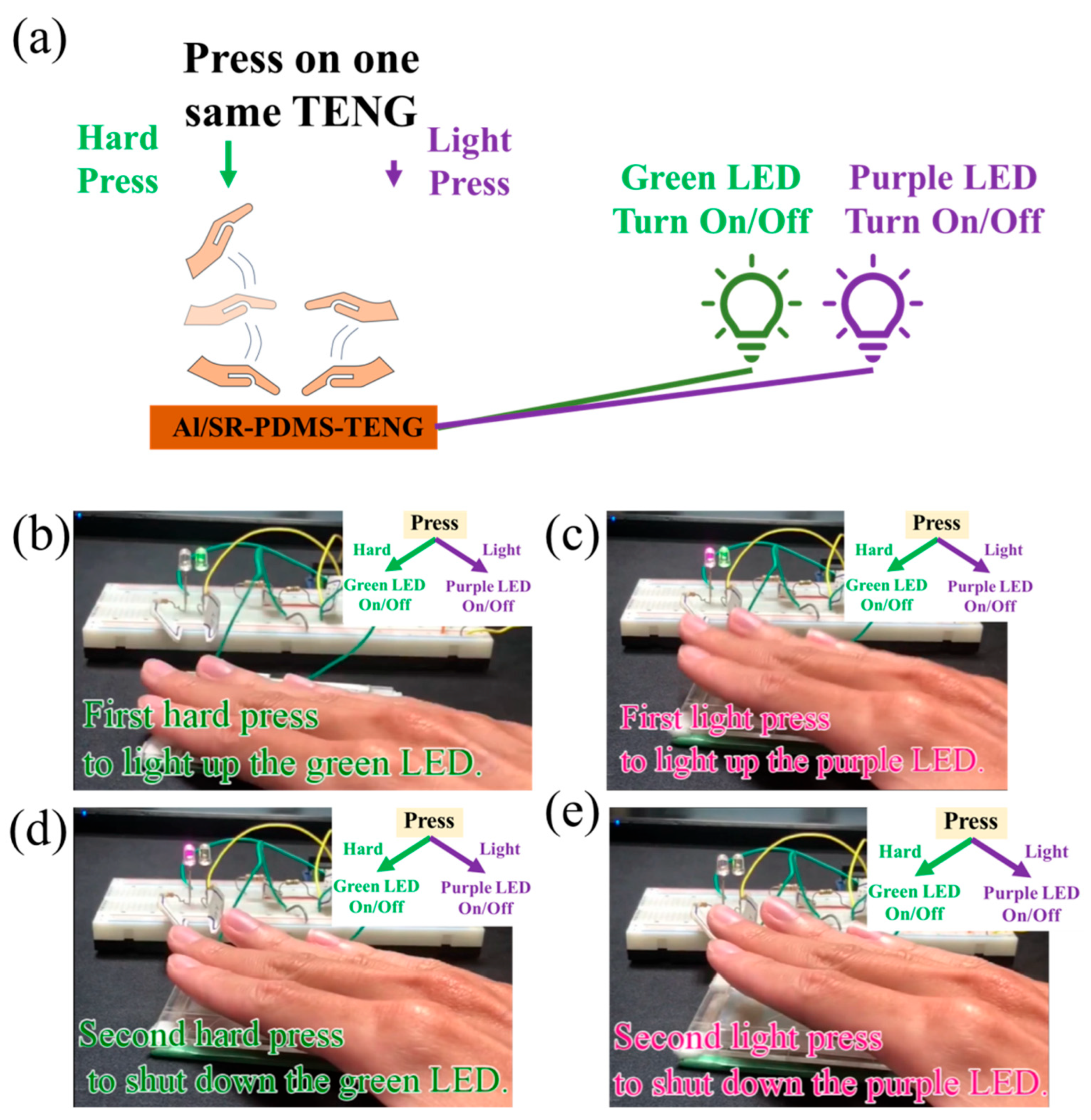
| Morphology | Surface Roughness Ra (μm) | Triboelectric Material | Fabrication Method | Open-Circuit Voltage (V) | Short-Circuit Current (μA) | Instantaneous Power Density (W/m2) | Ref. |
|---|---|---|---|---|---|---|---|
| Needle | Not mentioned | Al-PDMS | CO2 laser ablation | 102.8 | 43.1 | - | [20] |
| Pyramid | PET-PDMS | Photolithography | 18 | 0.7 | - | [21] | |
| Cube | <18 | <0.7 | - | ||||
| Line | <18 | <0.7 | - | ||||
| Nanodots | BCP-PTFE | Self-assembled BCP | 95 | 2.16 | 0.09 | [22] | |
| Nanogrates | 110 | 2.76 | 0.104 | ||||
| Crumpled | Au-PDMS | Spin coating | 75.3 | 7.4 | 2 | [23] | |
| Tiny burr arrays | CB@PDMS-PDMS | CO2 laser ablation | 70 | - | - | [24] | |
| Semi-ordered micro-sized structures | FEP-Nylon | Hot embossing | 30 | 7.5 | 0.0157 | [25] | |
| Rough | 10.9 (Random rough) | ACF-PDMS | Molding of sandpaper | 80.4 | 11.8 | 1.9 | [26] |
| Porous | 30–40 (Random rough) | Au/Ti-PDMS | Steam-curing | 1.6 | 0.15 | 0.00224 | [27] |
| Stripe Rough | 12 (Regular rough) | Al-PDMS | CO2 laser ablation | 97 | 59.6 | 1.54 | This article |
| Morphology | Roughness (Ra) | Triboelectric Material | Fabrication Method | Measuring Range (kPa) | Sensitivity (V/kPa) | Ref |
|---|---|---|---|---|---|---|
| Needle | No mentioned | Al-PDMS | CO2 laser ablation and molding | 0.2~2.4 | 3.11 | [18] |
| Rough | 13.2 nm | polymer-PBS/SR | Surface self-modified sustainable polymer | 2.1~62 | 0.135 | [46] |
| Micro-pyramid | Not mentioned | Human skin-PDMS | Etching and molding of silicon wafer | 0.4~7.3 | 0.29 | [37] |
| Nanorod | Not mentioned | Cu-FEP | top-down dry etching on FEP membrane | 3.1–9.4 | 3.2 | [47] |
| Crumpled MXene | Not mentioned | MXene-PET | crumpled structured MXene | 0.3–1 | 2.35 | [48] |
| Stripe-Patterned Rough | 12 μm (Regular rough) | Al-PDMS | CO2 laser ablation and molding | 0.19~1.9 | 14.14 | This article |
Disclaimer/Publisher’s Note: The statements, opinions and data contained in all publications are solely those of the individual author(s) and contributor(s) and not of MDPI and/or the editor(s). MDPI and/or the editor(s) disclaim responsibility for any injury to people or property resulting from any ideas, methods, instructions or products referred to in the content. |
© 2025 by the authors. Licensee MDPI, Basel, Switzerland. This article is an open access article distributed under the terms and conditions of the Creative Commons Attribution (CC BY) license (https://creativecommons.org/licenses/by/4.0/).
Share and Cite
Yu, C.-Y.; Hsu, C.-C.; Ku, C.-A.; Chung, C.-K. Stripe-Patterned Al/PDMS Triboelectric Nanogenerator for a High-Sensitive Pressure Sensor and a Novel Two-Digit Switch with Surface-Edge Enhanced Charge Transfer Behavior. Nanomaterials 2025, 15, 760. https://doi.org/10.3390/nano15100760
Yu C-Y, Hsu C-C, Ku C-A, Chung C-K. Stripe-Patterned Al/PDMS Triboelectric Nanogenerator for a High-Sensitive Pressure Sensor and a Novel Two-Digit Switch with Surface-Edge Enhanced Charge Transfer Behavior. Nanomaterials. 2025; 15(10):760. https://doi.org/10.3390/nano15100760
Chicago/Turabian StyleYu, Chung-Yu, Chia-Chun Hsu, Chin-An Ku, and Chen-Kuei Chung. 2025. "Stripe-Patterned Al/PDMS Triboelectric Nanogenerator for a High-Sensitive Pressure Sensor and a Novel Two-Digit Switch with Surface-Edge Enhanced Charge Transfer Behavior" Nanomaterials 15, no. 10: 760. https://doi.org/10.3390/nano15100760
APA StyleYu, C.-Y., Hsu, C.-C., Ku, C.-A., & Chung, C.-K. (2025). Stripe-Patterned Al/PDMS Triboelectric Nanogenerator for a High-Sensitive Pressure Sensor and a Novel Two-Digit Switch with Surface-Edge Enhanced Charge Transfer Behavior. Nanomaterials, 15(10), 760. https://doi.org/10.3390/nano15100760









